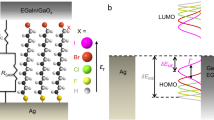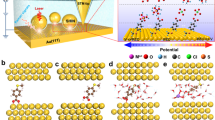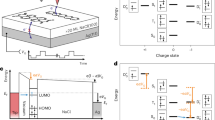Abstract
Transistors, regardless of their size, rely on electrical gates to control the conductance between source and drain contacts. In atomic-scale transistors, this conductance is sensitive to single electrons hopping via individual orbitals1,2. Single-electron transport in molecular transistors has been previously studied using top-down approaches to gating, such as lithography and break junctions1,3,4,5,6,7,8,9,10,11. But atomically precise control of the gate—which is crucial to transistor action at the smallest size scales—is not possible with these approaches. Here, we used individual charged atoms, manipulated by a scanning tunnelling microscope12, to create the electrical gates for a single-molecule transistor. This degree of control allowed us to tune the molecule into the regime of sequential single-electron tunnelling, albeit with a conductance gap more than one order of magnitude larger than observed previously8,11,13,14. This unexpected behaviour arises from the existence of two different orientational conformations of the molecule, depending on its charge state. Our results show that strong coupling between these charge and conformational degrees of freedom leads to new behaviour beyond the established picture of single-electron transport in atomic-scale transistors.
This is a preview of subscription content, access via your institution
Access options
Subscribe to this journal
Receive 12 print issues and online access
$259.00 per year
only $21.58 per issue
Buy this article
- Purchase on SpringerLink
- Instant access to full article PDF
Prices may be subject to local taxes which are calculated during checkout




Similar content being viewed by others
References
Park, H. et al. Nanomechanical oscillations in a single-C60 transistor. Nature 407, 57–60 (2000).
Kouwenhoven, L. P., Austing, D. G. & Tarucha, S. Few-electron quantum dots. Rep. Prog. Phys. 64, 701–736 (2001).
Liang, W., Shores, M. P., Bockrath, M., Long, J. R. & Park, H. Kondo resonance in a single-molecule transistor. Nature 417, 725–729 (2002).
Kubatkin, S. et al. Single-electron transistor of a single organic molecule with access to several redox states. Nature 425, 698–701 (2002).
Yu, L. H. et al. Inelastic electron tunneling via molecular vibrations in single-molecule transistors. Phys. Rev. Lett. 93, 266802 (2004).
Roch, N., Florens, S., Bouchiat, V., Wernsdorfer, W. & Balestro, F. Quantum phase transition in a single-molecule quantum dot. Nature 453, 633–637 (2008).
Song, H. et al. Observation of molecular orbital gating. Nature 462, 1039–1042 (2009).
Leturcq, R. et al. Franck–Condon blockade in suspended carbon nanotube quantum dots. Nature Phys. 5, 327–331 (2009).
Champagne, A. R., Pasupathy, A. N. & Ralph, D. C. Mechanically adjustable and electrically gated single-molecule transistors. Nano Lett. 5, 305–308 (2005).
Perrin, M. L. et al. Large tunable image-charge effects in single-molecule junctions. Nature Nanotech. 8, 282–287 (2013).
Burzurí, E. et al. Franck–Condon blockade in a single-molecule transistor. Nano Lett. 14, 3191–3196 (2014).
Stroscio, J. A. & Eigler, D. M. Atomic and molecular manipulation with the scanning tunneling microscope. Science 254, 1319–1326 (1991).
Koch, J. & von Oppen, F. Franck–Condon blockade and giant Fano factors in transport through single molecules. Phys. Rev. Lett. 94, 206804 (2005).
Ryndyk, D. A., Amico, P. D., Cuniberti, G. & Richter, K. Charge-memory effect in molecular junctions. Phys. Rev. B 78, 085409 (2008).
Nacci, C., Erwin, S. C., Kanisawa, K. & Fölsch, S. Controlled switching within an organic molecule deliberately pinned to a semiconductor surface. ACS Nano 6, 4190–4195 (2012).
Olsson, L. O.̈ et al. Charge accumulation at InAs surfaces. Phys. Rev. Lett. 76, 3626–3629 (1996).
Fölsch, S., Yang, J., Nacci, C. & Kanisawa, K. Atom-by-atom quantum state control in adatom chains on a semiconductor. Phys. Rev. Lett. 103, 096104 (2009).
Piva, P. G. et al. Field regulation of single-molecule conductivity by a charged surface atom. Nature 435, 658–661 (2005).
Riss, A. et al. Imaging and tuning molecular levels at the surface of a gated graphene device. ACS Nano 8, 5395–5401 (2014).
Lee, D. H. & Gupta, J. A. Tunable field control over the binding energy of single dopants by a charged vacancy in GaAs. Science 330, 1807–1810 (2010).
Swart, I., Sonnleitner, T. & Repp, J. Charge state control of molecules reveals modification of the tunneling barrier with intramolecular contrast. Nano Lett. 11, 1580–1584 (2011).
Fernández-Torrente, I., Kreikemeyer-Lorenzo, D., Stróżecka, A., Franke, K. J. & Pascual, J. I. Gating the charge state of single molecules by local electric fields. Phys. Rev. Lett. 108, 036801 (2012).
Teichmann, K. et al. Controlled charge switching on a single donor with a scanning tunneling microscope. Phys. Rev. Lett. 101, 076103 (2008).
Yang, J., Erwin, S. C., Kanisawa, K., Nacci, C. & Fölsch, S. Emergent multistability in assembled nanostructures. Nano Lett. 11, 2486–2489 (2011).
Stern, F. & Howard, W. E. Properties of semiconductor surface inversion layers in the electric quantum limit. Phys. Rev. 163, 816–835 (1967).
Schuler, B. et al. Adsorption geometry determination of single molecules by atomic force microscopy. Phys. Rev. Lett. 111, 106103 (2013).
Liljeroth, P., Repp, J. & Meyer, G. Current-induced hydrogen tautomerization and conductance switching of naphthalocyanine molecules. Science 317, 1203–1206 (2007).
Paulsson, M., Zahid, F. & Datta, S. in Nanoscience, Engineering, and Technology Handbook (eds Goddard, W., Brenner, D., Lyshevski, S. & Iafrate, G.) (CRC Press, 2003).
Nazin, G. V., Wu, S. W. & Ho, W. Tunneling rates in electron transport through double-barrier molecular junctions in a scanning tunneling microscope. Proc. Natl Acad. Sci. USA 102, 8832–8837 (2005).
Nazarov, Y. V. & Blanter, Y. M. Quantum Transport (Cambridge Univ. Press, 2009).
Fölsch, S., Martínez-Blanco, J., Yang, J., Kanisawa, K. & Erwin, S. C. Quantum dots with single-atom precision. Nature Nanotech. 9, 505–508 (2014).
Acknowledgements
This work was supported by the German Research Foundation (Collaborative Research Network SFB 658) and the Office of Naval Research through the Naval Research Laboratory’s Basic Research Program. Some computations were performed at the DoD Major Shared Resource Center at AFRL.
Author information
Authors and Affiliations
Contributions
J.M.-B., C.N. and S.F. performed the STM experiment and the experimental data analysis. K.K. performed the MBE growth of the InAs samples. S.C.E. predicted the charge-induced molecular reorientation based on density-functional-theory calculations. E.L. and M.T. performed the generic model calculations of the coupled electronic and conformational dynamics. F.v.O. and P.W.B. developed the generic model. J.M.-B., S.C.E., E.L., M.T., F.v.O., P.W.B. and S.F. co-wrote the manuscript.
Corresponding author
Ethics declarations
Competing interests
The authors declare no competing financial interests.
Supplementary information
Supplementary Information
Supplementary Information (PDF 900 kb)
Rights and permissions
About this article
Cite this article
Martínez-Blanco, J., Nacci, C., Erwin, S. et al. Gating a single-molecule transistor with individual atoms. Nature Phys 11, 640–644 (2015). https://doi.org/10.1038/nphys3385
Received:
Accepted:
Published:
Issue date:
DOI: https://doi.org/10.1038/nphys3385
This article is cited by
-
A solid-state quantum microscope for wavefunction control of an atom-based quantum dot device in silicon
Nature Electronics (2023)
-
Single molecule photonic transistor and router through plasmonic nanocavity
Applied Physics B (2023)
-
Internal Stark effect of single-molecule fluorescence
Nature Communications (2022)
-
Thermoelectric Effects in Tunneling of Spin-Polarized Electrons in a Molecular Transistor
Journal of Low Temperature Physics (2022)
-
Tunable giant magnetoresistance in a single-molecule junction
Nature Communications (2019)



